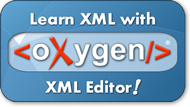DTD - XML Building Blocks


The main building blocks of both XML and HTML documents are
elements.
The Building Blocks of XML Documents
Seen from a DTD point of view, all XML
documents (and HTML documents) are made up by the following building blocks:
- Elements
- Attributes
- Entities
- PCDATA
- CDATA
Elements
Elements are the main building blocks of both XML and HTML documents.
Examples of
HTML elements are "body" and "table". Examples of XML elements could be
"note"
and "message". Elements can contain text, other elements, or be
empty. Examples of empty HTML elements are "hr", "br" and
"img".
Examples:
<body>some text</body>
<message>some text</message> |
Attributes
Attributes provide extra information about elements.
Attributes are always placed inside the opening tag of an element. Attributes
always come in
name/value pairs. The following "img" element has additional information about a source file:
<img src="computer.gif" /> |
The name of the element is "img". The name of the attribute is
"src". The value of the attribute is "computer.gif".
Since the element itself is empty it is closed by a " /".
Entities
Some characters have a special meaning in XML, like the less than sign (<)
that defines the start of an XML tag.
Most of you know the HTML entity: " ". This "no-breaking-space" entity is used in HTML to insert an extra space in
a document.
Entities are expanded when a document is parsed by an XML parser.
The following entities are predefined in XML:
| Entity References |
Character |
| < |
< |
| > |
> |
| & |
& |
| " |
" |
| ' |
' |
PCDATA
PCDATA means parsed character data.
Think of character data as the text found between the start tag and the end
tag of an XML element.
PCDATA is text that WILL be parsed by a parser. The text will be
examined by the parser for entities and markup.
Tags inside the text will be treated as markup and entities will be expanded.
However, parsed character data should not contain any &, <, or > characters;
these need to be represented by the & < and > entities, respectively.
CDATA
CDATA means character data.
CDATA is text that will NOT be parsed by a parser.
Tags inside the text will NOT be treated as markup and entities will not be expanded.


Learn XML with <oXygen/> XML Editor - Free Trial!
 |
|
oXygen helps you learn to define,
edit, validate and transform XML documents. Supported technologies include XML Schema,
DTD, Relax NG, XSLT, XPath, XQuery, CSS.
Understand in no time how XSLT and XQuery work by using the intuitive oXygen debugger!
Do you have any XML related questions? Get free answers from the oXygen
XML forum
and from the video
demonstrations.
Download a FREE 30-day trial today!
|
|